The Old School Memories Of Bygone Days
THE FIRST SCHOOL DENTAL CLINIC
By Jack Point
From the Blackburn Times of April 24 1937.
© BwD - terms and conditions
Passing the old school the other day, after many years, I was tempted to look in just to refresh memories of bygone days. I went through the yard, but what a shock was mine! Surely this pettifogging space was never the scene of so many strenuous football matches, of so many happy hours at cricket, at “trust” and “cap-on-back,” and all the boyish pastimes that made the playtime pass all too quickly. If memory served me aright, it was at least ten times the size. Why, it seemed to take us an age then to run from one side to the other. How it had shrunk with the years. Yet it was the same old playground, for there was the house where the caretaker—old Forrest—lived. Old Forrest, who was a second edition of President Lincoln in appearance, having a black goatee under his chin, was the one man whom we feared as much as we feared the head master himself, for he stood no nonsense. His wife was cast in gentler mould, and on a hot day we would sneak to the back door of the house, and beg drinks of water until her husband appeared, when, our terror swallowing up our thirst we vanished instantly.
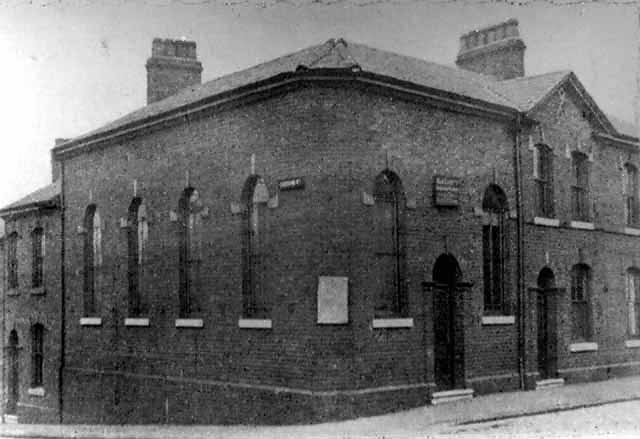
© BwD - terms and conditions
COCKPIT OF THE SCHOOL
There again just beyond the north wall of the playground, was “t’ back,” as we called it, where most of our boyish quarrels were settled. It was the cockpit of the school, and the fights, which took place there were very serious businesses indeed. At any rate, the preliminaries were serious. No Italian duello needed so much ceremony, and modern heavyweight championships have been carried through with no more arrangements.
An intermediary was always employed. If there was bad blood between Jones and Smith the intermediary would approach Smith and inform him that Jones had been saying he could “lick” him. If Smith told the intermediary that Jones couldn’t “lick” him, progress was being made. The next step was for Jones to catch Smith’s eye when the teacher wasn’t looking. Then Jones would give a most fearful scowl with his lower teeth showing over his upper lip and shake his fist. If Smith did likewise, the preliminaries were completed, and word went round the class like wildfire that there was a sanguinary combat in “t’ back” after school.
There was never much blood shed in these encounters, however, for the first good stout blow generally ended the contest and the victor usually strutted off, surrounded by a host of admiring friends, while the defeated one was left alone, deserted by his former supporters. This, however, was always the way of the world.
I peeped into the classroom itself. That had been considerably altered. Now it consists of a number of classrooms, but in my time there were two large rooms divided by a sliding partition. The partition itself consisted of two parts, which slid towards or away from one another along an iron rail. They were pushed apart at the opening and closing of school so that the two rooms became one, and pushed together again when lessons began. The pushing was done by a couple of lads who each grabbed an iron handle and pushed for all they were worth. If they achieved a tremendous bang when the partitions met, or reached the end of their rail the lads were highly delighted.
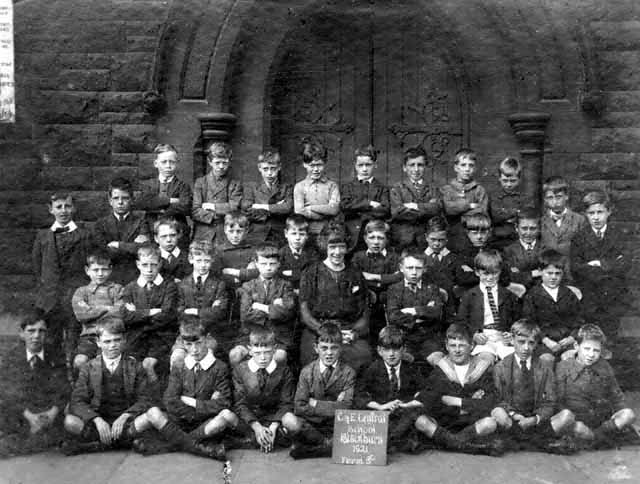
© BwD - terms and conditions
LEGEND OF THE HORSE HAIR
In addition to morning and evening prayer, we had grace before and after meat, and, strange as it may seem, though we all sang most lustily, it was mostly gibberish, as scarcely any of us knew the words, and it was a great surprise to me when I learned what the words really were. I am quite certain that if we had been asked to write the words the staff would have received a shock.
The teachers in the old school were very great on discipline, and corporal punishment was their way of obtaining it. Canes were generally used, and these varied from long to short, and from thick to thin. One of my teachers used to prefer long thin ones, and was in the habit of sending me to purchase them. My orders were always to purchase a sappy one, as the dry ones were apt to split up the middle very soon.
I can’t say I was particularly fond of this job, as I was sent back if the cane was unsatisfactory, while, if the teacher was pleased with it, I was none to popular with the rest of the class. This belief in sappy canes, however, was so widespread that in after years I met a head master who confessed that he kept his canes in water in a long, narrow-minded tin (as Teddy Whittle would have called it), so that they should always be nice and moist. Some of the teachers burned the ends of their canes, as it was thought that this prevented them from splitting. Some of the scholars burned the ends of the canes too, but this was because they found father’s twist rather to strong!
There was a legend at this time that if you put a horse-hair across your hand when you were being caned the cane would split, but so far as I was concerned it remained a legend, and fit company for the Indian rope trick for I never saw it proved.
Old Towler was the wisest of the teachers as regarded corporal punishment. He didn’t trouble about a cane—he used instead the top half of a substantial-looking walking stick. Having a knob on one end, it resembled a shillelagh as much as anything. There was no fear of that splitting. Even a horsehair wouldn’t do it. Canes might come and canes might go, but that went on forever, and if old Towler is doing any whacking now it’s odds he has his old shillelagh with him.
Comparisons are often made by old-stagers between the old education and the new, which are considerably to the disadvantage of the latter, but everything in the garden wasn’t lovely in those days, as a little reminiscence will show. In many schools then were very young pupil-teachers, whose duty as a rule it was to take the “exceptions” as they were called. These “exceptions,” being considered exceptionally dull of intellect, were generally pushed away in some obscure corner, where they were taught the alphabet and given some very simple exercises in numbers.
One pupil-teacher who was in charge of a class of this kind, and out of sight of everyone, found his job very irksome. He conceived the strange idea of extracting the pupils’ teeth for a change. Any lad who consented to have a tooth drawn was allowed to go home half-an-hour earlier. The idea caught on marvellously. I don’t know what time wickets were pitched, but “stumps” were drawn at all hours! Some of the mothers, however evidently considering this drawing of “stumps” was not quite “cricket,” intervened, and thus the first school dental clinic came to an untimely end.
Though his implements were of the rudest—merely a nail and a piece of string—who shall blame the youthful operator when learned professors tell us that the real meaning of “to educate” is “to draw out”?
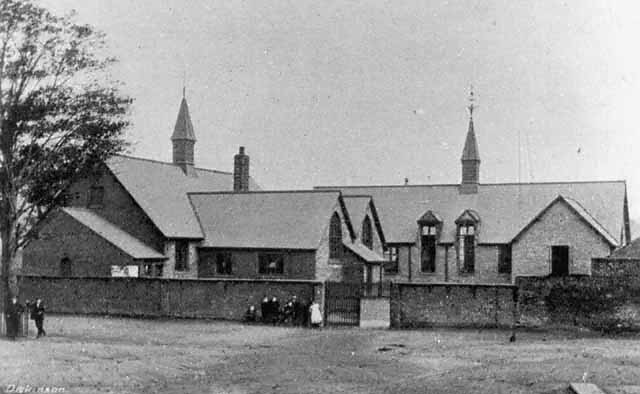
© BwD - terms and conditions
THE TUCK SHOPNo account of the old school would be complete without an allusion to the “tuck shop,” as I suppose it would be called now. It was a two-windowed shop at the corner, but only one of the windows interested us—the one facing the school, which contained sweets. Chocolate was not so much to the fore then. The most popular sweets were liquorice, horse or aniseed balls, “hot toffees,” one percent sugar and ninety-nine per cent cayenne, and acid drops. In some cases the sweets were not weighed, but were counted, and we knew exactly how many we ought to receive.
At one period the spirit of speculation was in the air, for “lucky balls” and “lucky turnovers” were introduced, and great was the excitement thereat among the scholars. In a few of these sweetmeats—a very few—a coin was hidden. It might be a halfpenny, it might even be a three-penny bit, so lucky sweetmeats were the order of the day until the authorities intervened.
One lad won quite a reputation as a “spotter.” He claimed to be able to tell the ones which contained the coins. He became the consulting expert. Sometimes he was sent in to make the purchase himself, sometimes he stood outside the shop window with the “capitalist” and indicated the one which was to be purchased. His fee—for every consulting expert must have his fee—was the toffee; his financial backer took the coin. If there were no coin, he received a small portion of the toffee.
At times we became vegetarians and devoured liquorice root, sweet locust, and “monkey-nuts” as we called them. Peanuts I suppose they would be called now. The liquorice in this case was the natural product. It was brown in colour, and consisted of long, tapering strands. The sweet locust was in appearance like pieces of dried black leather. It was easily chewed, however, and was rather pleasant to the palate.
There was much discussion amongst the lads as to whether it was the food of John the Baptist in the wilderness or not. But the question was never finally settled so far as I know. As regards the peanuts, one pioneer conceived the brilliant idea of eating the shells as well, and we all followed his example, and pretended to enjoy them, too, though I imagine that chewing a straw shopping basket would be just as toothsome. Which only goes to show that lads can persuade themselves into anything.
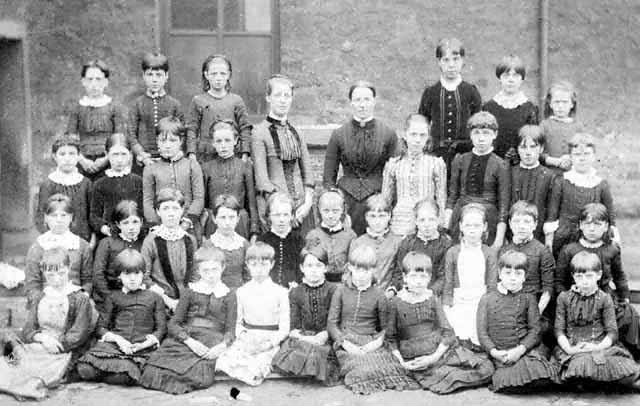
© BwD - terms and conditions
FORTUNES LOST IN MARBLESWe had many games such as are played to-day, but there were others. In the marbles we had a game called “Chuck-at-hoyle,” or “Odd and E’en.” We made a small hole close up to the schoolyard wall. Each player staked so many marble or “stooanies,” as we called them. One of the players threw the marbles against the wall just above the hole. Some marbles simply rebounded, others rolled into the hole, if the number of marbles in the hole were odd the thrower won, if even, he lost. Thus many a fortune (in marbles) changed hands in the old schoolyard, and no keener gamesters were ever found, no, not even in Monti Carlo.
Tops, too, in their season, were very popular, but we went beyond the common or garden order of top-spinning, and indulged in “top fights.” We whipped our tops up against each other so that they collided and one was knocked out. This, however, led to a certain amount of sharp practice, for some of the lads’ brought tops of such enormous size that the smaller tops had no chance against them. Others went further still and brought tops made entirely of steel, which were called “boilers” and when one of the wooden walls of old England came up against one of these steel-clad monsters it was a case of shiver my timbers and no mistake.
Of course, in all our yard games it was a case of “minding our step,” for old caretaker Forrest was a regular martinet, and a believer in corporal punishment, too. Though he did not, like the teachers, use a cane or a stick, he carried in his hip pocket a good stout two-foot rule, which, when occasion arose, he used just as effectively.
And now we must leave the old school. What was its name, you ask? Perhaps it was Narkover, perhaps it wasn’t. All I can say is that we hadn’t an old school tie, we hadn’t even a badge on our caps, but most of those who attended that school think that it’s the best school that ever was or ever will be. And who’s going to undeceive them? Well, I’m not, at any rate.
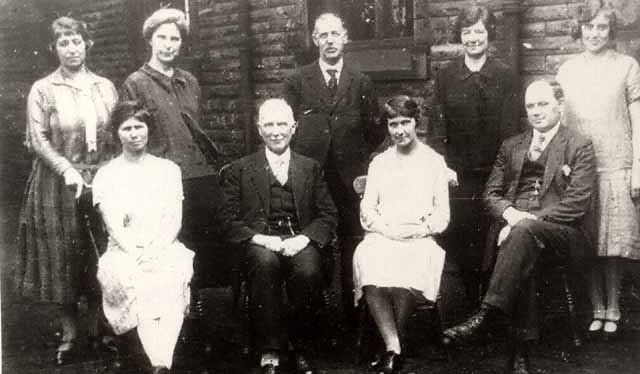
© BwD - terms and conditions
By Marian Beck.
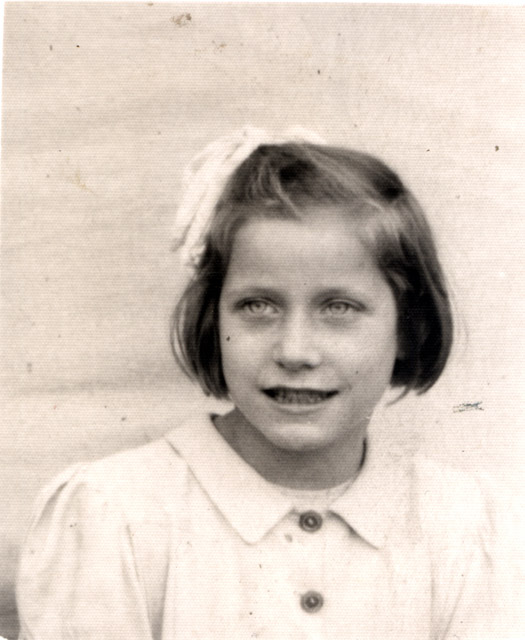
Marian Smith prior to starting at Bangor-street School
Reading about schools today and talking to young people about their thoughts and feelings on how they are taught and the way they behave makes me wonder what they would make of being at my school in the 1950’s. I am well aware that even for that day and age the regime at that establishment was strict in the extreme. The school wasn’t a swanky upper class organisation or even a grammar school, it was in a very modest part of Blackburn and most of the pupils came from poorer backgrounds but to say the standards were high would be a major understatement. My school was Bangor Street Secondary Modern School, home to youngsters who had failed the eleven plus exam.
© BwD - terms and conditions
Bangor-street School showing the girls playground. Fraternising with the boys was taboo.
Bangor Street School was a two storied, red brick building which housed 200 girls in the lower level and the same number of boys in the upper level, the crucial part of this arrangement was that the girls and boys never, ever came into each others company – it was a mortal sin for us girls to be caught talking to a boy. My friend Marjorie Robinson, remembers passing the time of day with a boy and being slapped hard by the gym mistress for doing so. It’s just as well the punishment didn’t put her off talking to the boy for good as the pair married in 1963; she became Mrs. Alan Thorne and they moved to Australia where they have lived for over forty years.
So strict was the rule on not talking to boys that I was told I could not walk home with my brother who attended the boy’s part of the school. The reason given was that I was in school uniform and the general public would not know he was my brother and might think there was some impropriety!!!! Even eye contact with the boys was discouraged and this proved to be a real problem when we had outdoor games. The boys would hang over the walls separating the two playgrounds and yell out inappropriate remarks - they were not put off by the constant cuffs across the ear which were doled out by their school masters. It didn’t help that we girls did our gym in blouse and knickers. Now this might sound like the key to raising a young man’s passion to great heights but believe me, if you saw the garments you’d wonder they bothered to look at all. We were allowed only one button to be undone on our voluminous white, long sleeved blouses and our regulation navy blue knickers were huge, baggy creations with elastic sewn around the legs which almost reached our knees; sexy they were not!!!
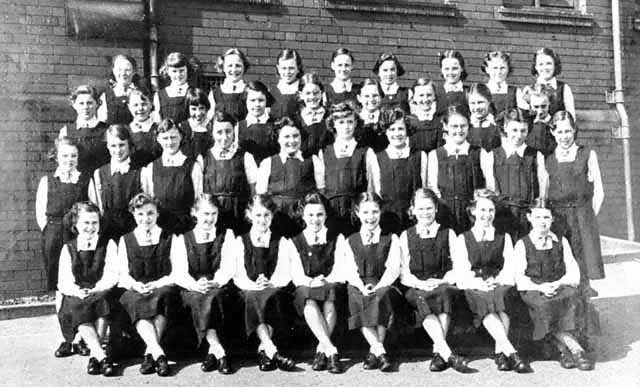
© LET - terms and conditions
A class photgraph of girls dressed in their immaculately cared for uniforms.
SCHOOL UNIFORM
School uniform played an important part in keeping up the image of the school. Our uniform consisted of a navy blue gym slip, a shapeless garment tied around the middle with a matching sash (prefects wore a distinguishing yellow sash), a white blouse, red and yellow striped tie, white ankle socks and black lace up shoes. Outdoor wear was a navy blue gabardine mac, a beret with the school badge on the front and in winter a red and yellow striped scarf and navy blue woollen gloves. Woe betide anyone who deviated from the laid down rules of correct uniform; no wearing a belt instead of the sash, no slip on or buckled shoes and to be seen in uniform out of school without your beret on it was a cardinal sin. Our uniforms were regularly inspected by the headmistress and I well remember girls being sent to press a crumpled gym slip or creased blouse in the ‘housewifery room’. The sight of anyone wearing jewellery, make up or nail varnish was enough to send the mistresses into shock and girls were sent to the staff room to be stripped of such fripperies.
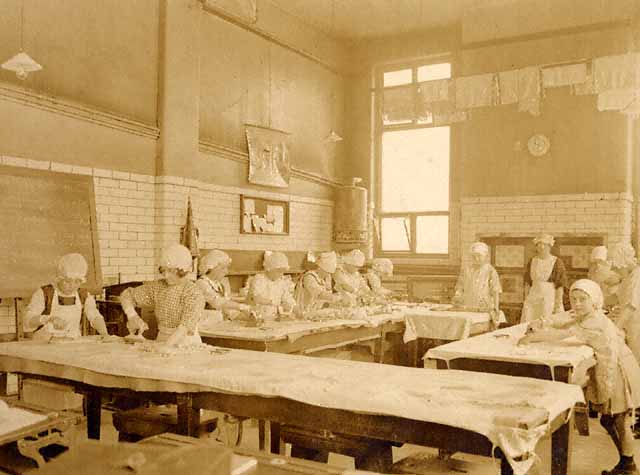
© BwD - terms and conditions
Cooking and housewifery was taken very seriously from the earliest days of the School
LESSONS
Every morning there was a formal assembly in the hall, teachers sat in a row on a stage and, as there was no seating, we girls sat in rows on the floor. We started each day with a hymn, a prayer, a talk from the headmistress and any notices which had to be made. This was the time when wrongdoers were often brought to book and I well remember a girl in my class who was a prefect and had been found playing truant the previous day, being brought out in front of the whole school and stripped of her yellow sash and badge. The poor girl was left standing in embarrassed isolation in her shapeless gymslip whilst the rest of the notices were read, accolades doled out to deserving pupils and the final blessing given. I’ve never forgotten the incident and wonder if the ‘human rights’ card would come into play nowadays!!
In the classroom we sat in rows of paired desks and most of our books were kept inside the desks, there was no humping of enormous rucksack around the school as is the case nowadays. Inkwells and nibbed pens of awful quality were still in use in the 1950s. and we all found it hard to master copperplate writing which was demanded of us. Every morning an ink monitor would go round filling up the inkwells so that we were ready for the days work; it was expected that this be done without spilling even the tiniest drop. Needless to say no one ever wanted to do the job.
All our lessons were done in a very formal way. In English spelling and poetry were learnt by rote as were our tables. This was always done for ten minutes or so before we got into the core of whatever we were doing. I have to say, I was never any good at arithmetic but I can still say all my tables without making any mistakes.
One of my very favourite lessons however, was cookery and housewifery. We didn’t just learn to cook, we learned to clean, wash, iron in fact everything that helped to run a house smoothly. I can’t see today’s young girls taking to lessons like that very easily but I enjoyed it enormously. Also we had the most inspirational teacher, Miss Smith, who made what could have been a mundane and tedious subject into something of interest. She was kind, caring and understanding and I’m glad she taught me.
© BwD - terms and conditions
Girls playing netball in their "knickers."
GAMES AND SPORTS
The playing of games and sports was always very much encouraged for the girls at Bangor Street. In the hall was a gym which included a climbing frame with ropes, a ‘horse’ and the ‘box’ for leaping over and a high jump bar. These were for use when we were unable to go outside for our PT lessons though the weather had to be pretty bad before we stayed inside. We had no playing field and games were played on the asphalt yard, there were many cuts and bruises from falling on the hard surface but, unlike today, health and safety was not an issue and just dusted ourselves off and carried on. Our main sports were netball and rounders but we also sprinted and had relays. All classes were split into four houses, Austen (green), Darling (blue), Mcdonald (my house, yellow) and Wordsworth (my friend Marjorie’s house, red). Our houses were pitted against each other for all games and there was a great deal of rivalry between us. Once a year we had a sports day where girls from all the schools in Blackburn competed against each other, this was held at Pleckgate and we sporty girls looked forward to it with relish.
Once a week we went swimming at Blakey Moor Baths. Our visit to the baths entailed a two mile walk whatever the weather. In winter the walk there was pretty daunting but coming back was truly awful when we were chilled to the marrow with our wet hair almost frozen to our scalps. Marjorie said her lasting memory was of the freezing cold wind whipping against her bare legs making them red and chapped. However, the summer walks were really quite pleasant and by the time we got to the baths a lot of us had divested ourselves of half of our uniforms in order to get in the pool quickly!! Our annual swimming gala was held at Belper Street Baths and again, this was something we looked forward to with great pleasure.
© LET - terms and conditions
Speechday at Bangor-street. Although this is in 1938 things would not have changed that much in the early 1950s.
SPECIAL OCCASSIONS
I think most girls in the school looked forward to the special times at school. It was a chance to get away from the routine of everyday lessons and do something different. We had nature walks when we would go into Corporation Park or into the countryside surrounding Blackburn (little of which is left now) to learn about birds, wild flowers and trees and I still remember a lot of what I learned on those walks. At Easter time we made cards and painted eggs in our art classes and always had a lovely service to celebrate as we did in autumn for the harvest festival. Then we would take fruit and vegetables which were given out after the service to poorer pupils and their families. Coming from a family of thirteen I was usually given something to take home but as my father was a gardener and my sister and I always took masses of produce we often ended up taking home the stuff we had taken in the first place!!!
Then of course was the best time of all – Christmas, how we loved Christmas; making the trimmings to decorate the classrooms, making Christmas goodies in cookery and of course, the nativity. I always loved that and longed to be chosen to take a main part in the play. However it was not meant to be and the best I got to do was to read a passage from the bible and sing a verse from the carol, ‘Oh Little Town of Bethlehem’. Nevertheless it was my favourite time and I still think about it all with fondness and joy.
These are some of my memories but I have so many more, far too many to be written down here. I hope there is someone out there who will see this, be reminded of their times at school in the 1950s and submit their memories to this wonderful site.
by Marian Beck (nee Smith)
Pupil at Bangor Street Secondary Modern School
From 1954 - 1957
By
Mike Sumner
I did my training at Chorley Teaching College and after completing my third teaching practice in 1968 I joined the staff of Pleckgate school in September 1969. I retired in 2012 after 43 years’ service. I can relate happy memories of the school with the use of my large archive that I built up over the years I spent there
Early History
There was a Pleckgate School at the top of St. James Road as early as 1860’s which catered for pupils from the local hamlets of Lammack, Pleckgate and Revidge Fold. Later the school moved down to the lower Pleckgate area as St Chads which also acted as a church.
Pleckgate High School History
In the 1960’s there were moves from the Government to change the existing school system from the three-tiered types of school, Secondary Modern, Technical College and Grammar Schools. At these school’s places were allocated top pupils according to the results of the 11-plus examination. In its place they introduced the Comprehensive School which contained pupils of all abilities this forced Grammar Schools to go private. Blackburn Education Authority created Pleckgate High School at a cost of £326,579 which they built as Blackburn’s showpiece first Comprehensive School to be located on a “Greenfield Site” on the outskirts of Blackburn. It first opened its doors on Wednesday 24th April 1968 but on the first day, the new Headmaster Mr. Peter Jolley had to tell the 600 new pupils to go home after lunch and not to return until the following Monday because there were still minor works to complete by the school’s contractors on the Language Laboratory and 200 desks had not been delivered. The pupils selected for Pleckgate High School came from the former Bangor Street Boys High School and Blakey Moor Girls High School and was planned to accommodate 660 pupils. The school site covered an area of twenty-seven acres with plenty of room to develop playing fields and further extensions to the school. The design of the school was, to some extent, limited by low bearing capacity of the sites ground resulting in a series of single storey buildings apart from the two- storey classroom block.
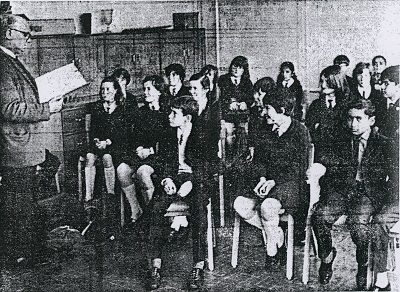
Mr. Jim Hayhurst a Woodwork teacher marking the register for a form of pupils who have seats but no desks before they were sent home.
Civil Defence Emergency Feeding Exercise with makeshift ovens on the grass area which was in front of the new school taken in 1954
The new High School taken in September 1968
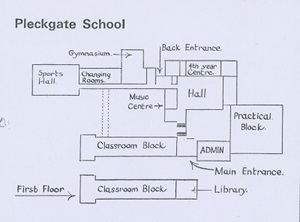
How the Original School was Made up showing its various teaching areasThe traditional Assembly Hall with stage was replaced by a more flexible area with an open stage which could also be used for dining. It had windows looking out to a courtyard with biology pool, paved areas and grass banks. The school also had a sports hall, the first to be built in Blackburn, which was twice the size of a normal gymnasium which was also added to the sports area. Another new feature of the school was a 4th and 5th year centre sited off the main hall this was used for teaching and a social area for senior pupils. The classroom block included a language laboratory, three science laboratories, a full range of normal classrooms and an excellent library. The lower floor was referred to as G block and the upper floor F block with G block covered Maths, English and Science and F Block included History, R.E., Geography and Science. Other specialist accommodation was developed in suites based on paved courts separated from the main teaching block by the administrative offices and staff room, with accommodation for art and crafts, housecraft and needlework, woodwork metalwork and technical drawing in J block. Prior to entry into the main hall there was the Music Centre classroom. As the school was designed for heavy use by school, Youth, Further Education and Community purposes there was a caretaker’s bungalow built at the front of the school so that the school could be better served out of normal school hours.
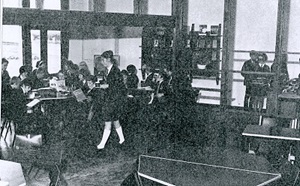
The school’s 4th and 5th year Centre.The new Sports Hall.
Pleckgate High School was officially opened on Tuesday 8th October 1968 by Alderman W. A. Henshaw who was vice-chairman of Blackburn Education Committee.
The First School Staff
Mr. P.B. Jolley – Headmaster, Miss E. Blackledge – Deputy Head, Mr. C. Crossley – Senior Teacher.
Mr. R. Adamson- First Year Housemaster- School Social Worker and Boys careers, Mr. J. Beardwood – Arts and Craft, Miss S. Brigham – French, Mrs P. Cave – temporary French, Mr. J. Crompton – 3rd. Year Housemaster, Mr. J. Eccles (Maths), Mrs. J. Edmundson (Home Economics), Miss H, Haigh (Head of R.E.), Mr. J. Hartley (Metalwork), Mrs. C. Haythornthwaite ( P.E.), Mr. J. Hayhurst ( Head of Technical Studies), Miss N. Holt (Head of Remedial Dept, Mr. A G. Hook (School Librarian/ Temporary Head of English), Mr. P. Jenkinson (French), Miss C. Kirk (Maths), Mr. Malin (Part- Time Latin), Mr. J. Morris (Head of Maths), Mrs. Mort (part- time Music), Mr. A Pomfret (Ethnic Teacher), Mrs. J. Pratt (English/History), Mrs. B. Redhead (Part-Time Biology), Mr. T. Redhead (4th Year housemaster), Miss J. Redwood (Head of Home Economics), Mrs. J. Rowntree (Chemistry), Mrs. M. Sandford (Needlework/Girls Careers), Mrs. F. Scholey (Head of Commerce), Mrs. M. Seymour(English), Mr. P. Shackleton(Head of Art), Mrs. M. Shaw (2nd Year Housemistress)/English), Mrs. K. Staziker(Head of Music), Mrs. J. Taylor (Head of Science), Mrs. P. Wall (Geography), Mrs. J. Wallace (Biology), Mr. R. Wareing (P.E.), Mrs. Weryell (Geography/History), Mrs. Whalley (Part-Time Geography/Needlework).
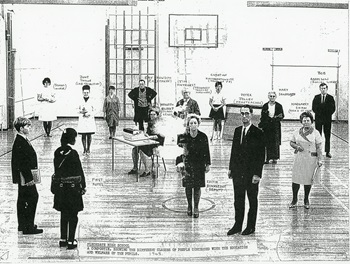
Members of the First School Staff posing in the School Sports Hall.
The 1970’s a Period of Major Changes.
During this period the school increased in size with the building of Blocks A, B, C, D, & E to the rear of the school which resulted in a large increase in pupil numbers, initially nine hundred and then on to intake levels closer to modern times. Blocks A, B, C, and D were opened in 1972 and E. Block in 1978. Over time A Block became a humanities area with mostly Geography and History, Geology and later Languages), B Block ground floor was used for a variety of activities including drama, media/film making, C. Block originally Science(prior to E Blocks creation) and some Technology and the Art Department), D Block created as a 6th Form Centre and when 6th form left was the Geography Department, E. Block was created to house the expanded Science Department and the R. E. Department). During the period of growth and the building phases various groups of children had to be housed in annex buildings including Four Lane Ends School, Blakey Moor Boys School and St. Chads Church. At the same time the school staff numbers had risen to 72 in 1974 including a Youth Tutor, Five Year Heads and a Head of Sixth Form and the need to cater for increased numbers of Ethnic children. Another change was the curriculum which now included new subjects giving pupils a greater choice including Integrated Studies (1970), 6th Form subjects (1973) Media studies (1976) Geology (1976) and Drama all of which led to increased and improved GCE O Level and A Level pass rates above the national average as the Headmaster Mr. Keith Walmsley could tell parents at the 1978 Speech Night. By 1979 GCE/CSE courses on offer included French, German, Geography, World Studies, Geology, Modern History, Commerce, Typewriting, R.E., Comparative Religion, Social Education, Music, Art, Metalwork, Woodwork, Technical Drawing, Domestic Science, and Needlework. The school also started to recognize the importance of school trips for widening pupils' education and was developed by Year Teams taking pupils to various locations including London, Chester, York and Knowsley Safari Park. The development of the Duke of Edinburgh Award Schemes at Bronze, Silver and Gold Levels led to pupils being taken to the Lakes especially Keswick for outdoor pursuits. Foreign holidays also took place organised by the Language Department with trips to France and Germany and exchange holidays, there was also sports holidays with early ski trips to Austria and the French Pyrenees, a football tour to Belgium and Geography trips to Switzerland and Russia.
During the 1970’s the school first organised several notable Stage Productions starting with Oliver (1973), Oklahoma (1976), South Pacific (1978) and Staff and Year Group Shows. The school also organised various money raising events for Charity from an early date and by the late 1970’s had a well- developed Parent Teacher Association which helped the school organize events to raise money both for charity and specific school targets.
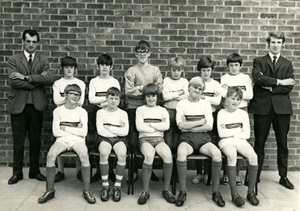
First Year Football Team During the 1969/70 SeasonBack Row – Mr. Frank Largan (Manager), Neil Harrison, Paul Flannery, Andrew Ingham, Christopher Bardsley
Paul Smith, Stephen Wallace, Mike Sumner (Manager)
Front Row – David Silson, Alan Walsh, Gary Chapman, Stephen Lucas, Paul Standring
Meeting of the First Integrated Studies Team in October 1970 at Blakey Moor.
From left to Right – Peter Doidge, Mary Lions, Judith Rowntree, Mary Whalley, Eileen Wallace Margaret Seymour and June Pratt
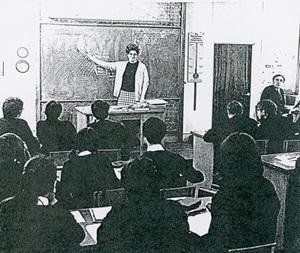
Mrs Pat Wall Delivering a Geography Lesson in Classroom F8 in !970
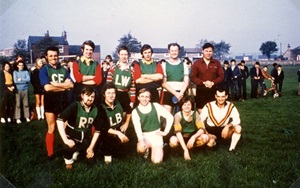
Staff Football Team whoplayed the Senior Pupils Team
Result a 3–3 draw.
Back Row - Roy Wareing, Mike Sumner, Eric Hartley, Peter Jenkinson, Brian Pearson, Geoff Eccles.
Front Row – Peter Barker, Mike Hardacre, Mike Emery, Adrian Crook (Student), Frank Largan
3MSTutor Group in 1969/70.
Back Row – Peter Fryer, Adrian Kenyon, Mike Sumner (Tutor), Geof Eccles (Deputy Year Head), David Pilkington.
3rd Row – Mehrunisha Ahmed, Mariyam Mohmed, Gaynor Llewellyn, Sharon Mullany, Elaine Rowan, Linda Mason, Linda Boothman.
2nd Row – David Whalley, Ronald Longworth, Stephen Morris, David Topham, Tanvir Ahmed, Mark Smith,
Front Row – Julie Baron, Hilary Peak, Diane Chew, Margaret Shaw (Head of Year), Tina McKay, Christine Forrest, Jean Walker.
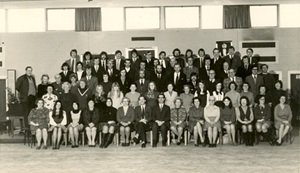
Pleckgate School Staff in 1974Back Row – Mike Sumner, Roger Livesey, Peter Doidge, Frank Cook, Mr. Thornton, Mike Emery
Mr. Carter,Mike Dyson, Eric Pomfrett, Eric Hartley, Brian Holden, Mike O’Grady, Dave Settle
Forth Row – Alan Taylor, Brenda Redhead, Nick Clements, David Hook, Frank Largan, Roy Wareing
Peter Shackleton, John Hartley, Brian Pearson, Peter Broadbent, Jack Morris, Craig Rossiter
Third Row – Ray Howson (caretaker), Betty Swancott, Les Lee, Pauline Mason, Rick Grogan, Kathleen Emery
Peter Jenkinson, Jimmy Crompton, Terry Hand, Mike Hardacre, Jim Hayhurst, Jerry Hyde, Geof Eccles
Second Row – Miss Moss, Kathleen Cowell, Margaret Whiteside, Mary Whalley, Susan Hudson, Murial Bainbridge, Mrs. Ross
Mrs. Bridge, Mrs. Jackman (Secretary), Pat Taylor, Eileen Jones, Jean Edmundson, Norma Holt, Margaret Shaw, Mrs. James
Front Row – Mrs. Colbert (Secretary), Lynne Edmunds, Jean Entwistle, Mrs. Scholey, Shelley Baynam
Margaret Karpinski, Cyril Crossley, Peter Jolley (Headmaster), Edith Blackledge (Deputy Head), Mary Whalley
Mary Sandford, Pat Rushton, Eileen Wallace Jennifer Colbert, Jean Redwood
School Football Trip to Belgium in 1976.
organised by Mr. Keith Walmsley (Headmaster), Mr. Peter Doidge and Mr. John Halsall
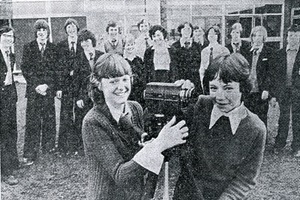 Pleckgate School Movie- Makers fourteen year olds Karen Maddox and Kathry Hughes with Camera
Pleckgate School Movie- Makers fourteen year olds Karen Maddox and Kathry Hughes with Camera
The film making was organised by Mr. Dave Settle Director of Studies. The students sent three 8mm films to a National ”Let's make a Film” Festival, two were chosen for screening at the National Film Theatre in London on 16th October 1976.
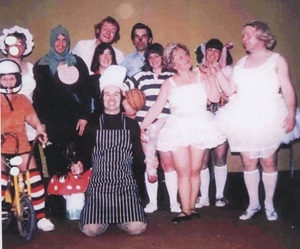
Fifth Year Leaving Party showing the staff who put on the Production in 1977Back Row – Mike Emery, Ian Morgan, Trevor Elliot, Josie Ashton, Frank Largan, Anne Taylor, Lynne Edmonds.
Front Row – Margaret Shaw, Mike Sumner, Edith Blackledge, Jack Morris.
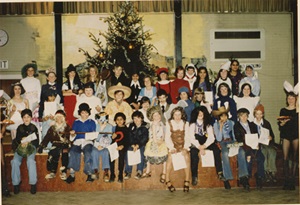
First Year Fancy Dress Competition in December 1977
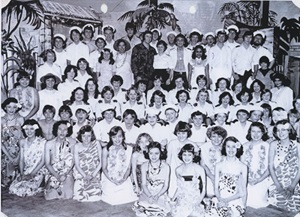
The cast of the School Production of South Pacific staged in 1978
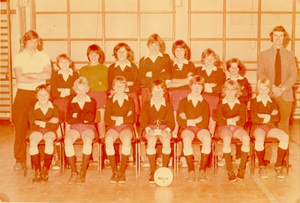
First Year Boys Football Team in 1978.
Back Row – Alan True, Andrew Alston, Andrew Wilson, Paul McGarvey, Gary Meadows, Kennth Woodhouse, Asif Saddique, Ian Hey.
Front Row -Neil Isherwood, Howard Best, Philip Hindle, Dave Fowler, Trevor Holden
Second Year Girls Hockey Team in 1979
Back Row – Heather Driver, Alison Belton, Jill Taylor, Alison Metcalfe, Carolyn Briggs
Front Row – Joanne Buckley, Susan Hargreaves, Joy Wareing, Deanne Gallagher, Jayne Thurston, Michelle Holden
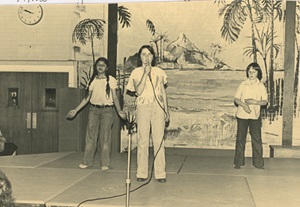
Pupils Entertaining Parents at a Charity Fund raising Event in 1979 with
Paula Roberts singing with Najma Moosa and Julia Fleming acting as backing singers
The 1980’s era
In 1982 there was sad news for the school as Lancashire Education Authority organised two Tertiary Colleges at St. Mary’s and Blackburn Colleges and closed local school Sixth Forms including ours at Pleckgate despite all efforts to protect our Sixth Form. This led to five members of our staff moving to Blackburn College including Dave Bacon, Dave Settle and Jim Cunningham. At this same period the school introduced an Outdoor Pursuits Week for third. Year Pupils centred on a large year party attending the YMCA National Centre at Lakeside to enjoy a variety of outdoor pursuits under the centre’s staff tuition. Pupils who didn’t attend the Lakeside Centre were engaged in local outdoor pursuits with school staff. The school curriculum was also enhanced as we appointed Lancashire’s first full time Urdu teacher Ateeqa Sheikh. By the end of the 1980’s the G.C.E. and C.S.E. external exams had been replaced by GCSE exams which came under criticism as they had less emphasis on longer written answers and introduced course work and the use of calculators. Another change was the introduction of modern Technology using computers and motorized micro-chip technology although equipment was expensive. Additional links were also made with local industry with the introduction of a two- week Work Experience Placement, Industry Day and Mock Interview Evenings for 4th Year Pupils. By 1987 the school had developed a strong” Duke of Edinburgh” Team and thirty-one pupils had gained awards with the team led by Tom Redhead and Cyril Gregson with organised trips to the Keswick area.
During the 1980’s there were many sporting achievements, especially with our football with teams reaching finals at Ewood Park from 1982-1985. At the same time Rugby was introduced to the sports curriculum and on the badminton side the 5th Year girls won the Lancashire Red Rose Championship and the boys’ team were runners up in the Blackburn league. In 1988 the 1st, 2nd, and 3rd Year Girls Teams were Blackburn Cross- Country Champions.
Other highlights from this era include school productions with the staff putting on “The Good Old Days” in 1982 to raise money for the school’s P.S.A. and the school producing “Love from Judy” in 1980 and the “Wizard of Oz” in 1985. Multi-Cultural Development in school was enhanced in 1989 with an “East Meets West Cultural Celebration” with a variety of activities including a Fashion Show. During the 1980’s the school produced its own school magazine called “Plex-Press” which continued in later years although with changed names. School Foreign Holidays continued to be popular. vVsit were organised to Belgium, Holland, Paris, Loire, Russia and Austria. On the musical front the 2nd Year Girls won the Durham Shield at Blackburn Music Festival (1984) and David Skidmore auditioned for the London Symphony Orchestra in 1987. Throughout the eighty’s the school raised thousands of pounds for nominated charities and Nick Morley who suffered severe leg injuries prior to becoming a teacher at Pleckgate raised nearly £10,000 via a bike ride. In 1987-1988 Suzanne Liddle, a 5th Year pupil became Blackburn Mayoress when her mother became Mayor as did staff member Anne Taylor when husband Bill became Mayor. In 1988 the school held a 20th Anniversary Dinner at the Spread- Eagle Hotel in Sawley and in the mid-late 1980’s most of the School Management Team retired including the school Headmaster Keith Walmsley, the Deputies Cyril Crossley and Margaret Shaw and Senior Teachers Jim Crompton, Tom Redhead and Jack Morris. The school gained a new Headmaster in September 1988 namely Len Scott.
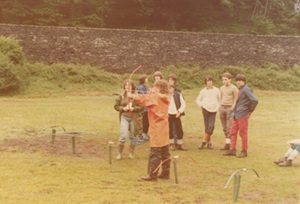
Archery and Canoeing activities at the Lakeside Outdoor Pursuits Centre in 1980
when 3rd Year Pupils Visited during Activities Week.
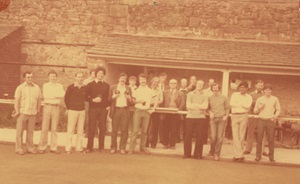
Men’s Staff Bowls Evening organised at the Butlers Arms at Pleasington in June 1981Left-Right—Peter Staziker, Eric Hartley, Peter Jenkinson, Gareth Marks, Derek Beatie, Mike Emery, Mike Turner, Jim Crompton,
Cyril Gregson, Jim Hayhurst, Ellis Metcalfe, Brian Holden, Dave Hunt, Derek Cox, Peter Doidge, Shabir Shahin, John Clough (Governor), Craig Smith
Retirement party for Jack Morris at the Castle Hotel in Clitheroe 1982.
Left to right- Peter Shackleton Margaret Shaw, Jim Hayhurst, Jim Crompton and Jack Morris
The school’s first Year Football Squad at Ewood Park where they won the Clarence Trophy beating St. Wilfred’s High School 3-0 in the final in 1983
Back Row – Jon Mercer, Darren Marsden, Stuart Allen, Michael Tinsley, Nicky Lord, Alaster Cameron, Jason Smith, Peter Darcy, Leigh Whittaker
Front Row – Andrew Bentley, Gavin Dinsdale, Marcus Barnes, Michael Sharples, Edward Tomlinson, Dean Foreshaw, Talbot Boulton, Andrew Gaston
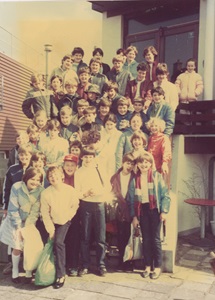
The “Op De Hoogte” Hotel entrance at Noordwijk Ann Zee Holland on the Easter 1983 1st Year trip to Belgium and Holland.
Second Year Girls, Winners of the Under sixteen recorder group and Durham Shield Winners for all ages at the Blackburn Music Festival in1984.
Left – Right – Catherine Aldwinkle, Sarah Duxbury, Louise Henry, Lisa Jeffrey, Katrina Young and catherine Brindle
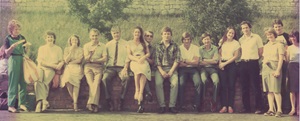
Staff at rest on the 2nd Year Trip to York in 1984.
Left – Right; Lynne Crook, Gill Gledhill, Anne Taylor, Frank Largan, Cyril Gregson, Carol Sourbuts, Nick Clements, Nick Morley,
Peter Briggs, Eric Hartley, Meryl Urry, Ian Morgan, Barbara Hall, Kevin Dobson, Josie Smith
 Tracey Heyworth and team who provided a Cabaret at an Old Peoples Home in 1985
Tracey Heyworth and team who provided a Cabaret at an Old Peoples Home in 1985
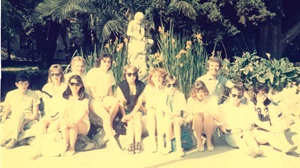
School party posing on the 1986 Easter Holiday in Athens Greece
Left –Right; Ian Duckworth, katy Markham, Tina Fu, Karl Wilding, Jayne Duckworth, Alison Scarr, Joanne Singleton,
Catherine Sumner, Adele McGregor, Mike Sumner, Lisa Jeffrey, Marie Farmer

Fifth Year Leavers Party at the Red House, Bolton Road in 1987
First Year Cross Country Squad who were Champions of the Blackburn with Darwen Schools in 1988 with second and third year Participants.
Back Row–Annisha Moosa, Jane Bradley, Fiona Lear, Sylvia Cummings, Sarah Brunt, Victoria Hartley
Middle Row–Michelle Hargreaves, Vicky Walmsley (Individual Winner to represent Lancashire)
Front Row–Gillian Foster, Nina Mercer, Andrea Eddleston

Pleckgate School’s twentieth Anniversary Dinner Dance for Staff at The Spread-Eagle Hotel, Sawley in April 1988
Left to Right–Margaret Shaw, Mike Sumner, Mrs Walmsley, Jim Crompton, Mike Turner
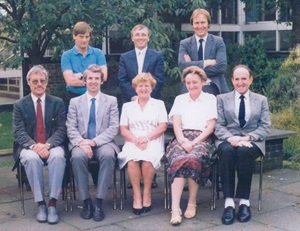
School Senior Management Team in 1988 taken in the Pond Courtyard.Back Row–Peter Briggs, Mike Emery and Mark Brownridge.
Front Row–Geoff Eccles, Mike Sumner, Margaret Shaw, Jennifer Colbert and Tom Redhead
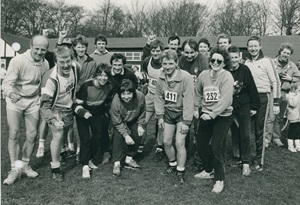 Rotary Club Charity Fun Run in Witton Park in 1989
Rotary Club Charity Fun Run in Witton Park in 1989Left to Right–Len Scott (Headmaster), Gordon Sudworth, Keith Hassell, Eric Pomfret, Kevin Dobson, Leslie Moulsdale, Christine Haworth,
Ian morgan, Ian Eastwood, Peter Briggs, Fred Bowdler, Mark Brownridge, Anne Taylor, P. Barton, Mike Sumner, Anne Hartley, Eric Hartley
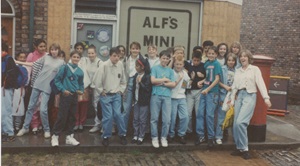
Third Year Group of Pupils visiting Coronation Street during Activities Week in 1989
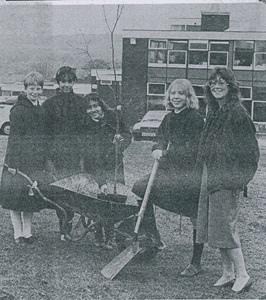 Jamie Allen, Nabila Zeb, Nemath Raheem and Emma Swimby with the Geography Environmental Studies Teacher Lesley Davies
Jamie Allen, Nabila Zeb, Nemath Raheem and Emma Swimby with the Geography Environmental Studies Teacher Lesley Daviesplanting a beech tree at the rear of school as part of National Tree Week in December 1989
The 1990’s Era
During this period, the school increased its curricular links to the wider community including exchange visits to Blackburn’s Twin Town Altena, Germany with visits to Holland and France. Peter Briggs and Carol Sourbuts also developed links to schools abroad via a link to Fort Dorchester High School in Charlestown, South Carolina, USA in 1996.
The Geography Department became involved in undertaking Road traffic Surveys at Brownhill Roundabout due to local concerns over air and noise pollution and increased road traffic. The results passed to the local Environment Agency. Eventually this issue led to the opening of the M65 motorway to help divert traffic round the town and reduce it at Brownhill (1997-1998). In 1990 “Compact” was formed to forge links between industry and the school via Joan Gill. Industry Day and Work Experience continued at a pace, the school also got involved in ELTEC’s Extend Programme offering modern apprenticeships. During 1991, 1992 the school created links with the Armed Forces with visits by the Queen’s Lancashire Regiment and the RAF. From 1990 the school introduced Green Issues by cleaning up its grounds and introducing better litter bins. In 1991 we won the National “Grimewatch” Award presented to Mike Sumner by Brian Gould, the Secretary of State for the Environment. In 1997 the school started to celebrate a “European Week” and Judith Mallam became involved in Community Aid Programmes to Romania.
The Curriculum was advanced through Technology during this era with Pleckgate becoming the first East Lancashire School to receive cable TV Technology and a new multi-channel service. This allowed Modern languages to receive direct programmes from European Countries in 1991 and the school to receive a wealth of new Educational Material. In 1992 a school “News Programme" made its debut filmed via our Media Centre TV Studio in B1 linked to Blackburn College's Educational Channel. On the Music and Dance front Lee Turner was a finalist for the Young Guitarist of the Year in 1990, former pupils Tracey Heyworth landed a lead role in Starlight Express in 1991, and Catherine Grimes won a place at the National Youth Theatre in 1992 and later went on to star in TV series “The Bill". Zoe Tompkins was awarded a place at a top London Stage School in 1994. The school continued its tradition of producing stage productions with “Picture of Love" in 1991, “Hotel California" in 1992, “Dinner Theatre" in 1995, “Thwarting of Baron Bellignew" in 1996 and “Toad of Toad Hall" in 1998.
On the Sports Scene the second Year Boys Team reached a football final in 1991 and won it in 1995 together with the Blackburn Cup. Helen Entwistle our PE Teacher won Blackburn's Sports Personality of the Year in 1992 and became Lancashire's Number one Badminton Doubles player. Josie Smith a Technology Teacher at the school also climbed the Matterhorn in 1995. Starting in the early1990's the school began Summer Schools for Primary Pupils with both Literacy and Numeracy schemes together with sports activities and developed a Gardening Club using a greenhouse and created school gardens. One of our pupils Julie Warren created five huge murals on the wall of J Block corridor. The school sadly lost its Geography, Geology Teacher (Peter Doidge) and Science Teacher (Shabir Shahin) together with former Technology Teacher (Jim Hayhurst).
During the middle years of the 1990’s severe budget cuts affected the school leading to redundancies and early retirements with the closure of some local links. Later in 1999 the issue of school places reached the press and with Pleckgate School being badly over- subscribed many parents were unhappy when they failed to get their children into the school. On the staff front the Headmaster Len Scott retired in 1997 and his deputy Heather Jamieson took over with Robin Campbell arriving as her Deputy Head when Paul Oates retired.
In 1993 the school celebrated its twenty-fifth Anniversary with a staff dinner at the Spread- Eagle Hotel in Sawley and put on a further dinner for staff and former pupils in school with an exhibition of past school events and entertainment on stage by Tony Jo and Paul Sultana. Later in 1998 the school’s thirtieth Anniversary was celebrated with a Dine and Theatre presentation in school organised by Heather Jamieson. On the school site facilities were enhanced by the science labs being upgraded and a further one created (G10) during 1993 1994 at a cost of £180,000.
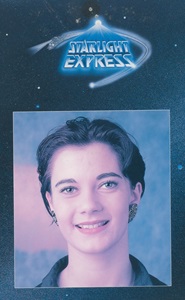
Former pupils Tracey Heyworth (1982-1987) who landed a major role in the main London
Musical “Starlight Express” in 1991 and Catherine Grimes who gained a place at the National Youth Theatre in 1992
School production of “Hotel California” staged in 1992 produced by twelve-year-old Ben Holt and helped by Lizzie Turner both year eight pupils
Julie Warren a Year eleven pupil with the five murals she painted displayed along J Block Corridor showing different facets of school life in 1990
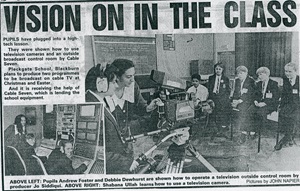
Cable Seven who were brought in to show pupils how to use television cameras
Staff netball team prior to playing an eleventh Year Team in the Sports Hall.
Back Row- Mike Emery, Len Scott, Ian Morgan, Rick Grogan, Gordon Sudworth, Peter Briggs, Jane Lippett,
Student, Sue Gordon, Angela Turner, Aldwyth Pearson, Helen Pallett, Jenny Sides
Front Row – Andrew Perman, Allan Dawson Chris Dobson.
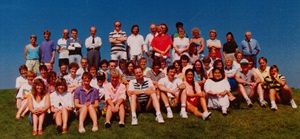 Staff members on the sports field prior to a run for charity in 1995.
Staff members on the sports field prior to a run for charity in 1995.Carol Sourbuts and Peter Briggs who developed links with a school in Charleston, South Carolina, USA
planning a route for their trip with a map of South Carolina in 1996.
Pleckgate School Staff in 1999
Back Row–Bob Dean, Ian Morgan, Damon Flynn, Dave Grimshaw, Phil Campbell, Rick Grogan, Mark Brownridge, Graham Windall, Dave Hunt,
Mike Parker, Rob Hamilton, Hanif Gire, Dennis Edgerley, Nick Clements, James Clegg, Mike Sumner, Alan Brown.
Forth Row–Carol Mason, Zoe Milllest, Jane Lippitt, Leslie Wilson, Robin Campbell (Deputy), John Dunsby, Gordon Waddicor
Peter Briggs, Alan Dawson, Eric Pomfret, Ken Lord, Peter Jenkinson, Asghar Ali, Fred Edwards, Heather
Jamieson (Headmistress), Debbie Woods, Helen Pallett, Leslie Chatburn.
Third Row–Shiela Wilson, Kathleen Emery, Jillian Eddleston, Rosie Morgan, Kathleen Jenkinson, Austin Lynch, Bill Harris,
Ibrahim Wadee, John Kay, Gordon Sudworth. Dave Isherwood, Mike Emery, Graham Griffiths, Wendy Bridgeman,
Sue Counter, Rosanne Jeal, Sarah Redfearn, Wendy Clarkson.
Second Row–Mesato (Student), Aldwyth Pearson, Sue Sullley, Miriam Nazeem, Jennifer Colbert, Cynthia Croydon,
Margaret Evans, Angela Stephens, Jill Cameron, Ateeqa Sheikh
Front Row–Barbara Horsefield, Kathryn Lawrenson, Naheda Hussain, Sue Gordon, Anne Taylor, Carol Soubuts, Helen O’Connor,
Diane Hacking, Valerie Lawrenson, Janet Archer, Sheila Robbins, Janet Conlon, Claire Barton, Josie Simms, Pat Rushton, Joan Taylor
Pleckgate School in the 2000’s
This era saw large and ever-changing educational development with more global experiences and major advances in technology as computers became smaller, more adaptable, more powerful and provided global communications at the touch of a button. To the dismay of an old hand such as myself blackboards started to be replaced by Interactive Whiteboards. Educational opportunities increased additionally with the introduction of I Pods, Video Conferencing and Mobile Phones and Computers.
During the 2000’s the school staff increased considerably with the Introduction of Teaching Assistants, Mentors, Pastoral Managers, Extra Technicians and Administrative Staff. At the same time Heads of Year became Learning Managers to reflect the change of emphasis towards monitoring pupils learning objectives. School also developed more International Links via South Africa, Denmark, Pakistan, India, Ivory coast and Ghana with our pupils becoming global citizens. The school’s international recognition increased in 2006 when Condoleeza Rice, the American Secretary of State, visited the school with Blackburn’s M.P. Jack Straw which created Press and TV coverage. During this period, the school also received Specialist College Status as a Maths and Computing College in 2005 and later a second Specialist status for English and Literacy. These have led to large scale refurbishment of the school’s IT and Maths facilities. The school also benefited from the opening of a City Learning Centre opened by the LEA at the front of school whose facilities are pupils could use.
In 2003 Robin Campbell became the Headteacher replacing Heather Jamieson who moved on to a new post. In 2004, 2007 and 2011 the school received good to outstanding Ofsted Inspection reports. In 2007 the school started its own Radio Station to produce podcasts that could be distributed via the Internet and strong links were also established with BAE Systems to forge engineering skills and started Pre-Driving Training days for Year ten pupils. On the sports scene Daniel Guppy (ex-pupil) became the British Ice- Skating Champion in 2000 and Years seven and eleven girls’ netball teams won their leagues. The boy’s football, badminton, cricket teams all won local competitions between 2004 and 2006. Outdoor Pursuits expanded over the period with visits to centres in the Yorkshire dales, North Wales and the Lake District with numbers involved with the Duke of Edinburgh Scheme continuing to rise.
During the 2000’s the school staged various productions including Yesterday (2001), Bugsy Malone (2002), Wizard of Oz (2003), Little Shop of Horrors (2004), Joseph and his Amazing Technicolour Dreamcoat (2005), Oliver (2006), Musical Magic (2007) and Grease (2009).

Staff Christmas Production for the pupils in December 2000
The winning team with their design project and representative during the Industry Day in 2003
Governor Alan Walsh interviewing a Year ten pupil During the 2004 Mock Interview Evening
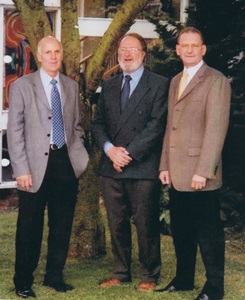
Three senior members of staff retiring in 2004, Peter Jenkinson, Denis Edgerley and Nick Clement
The American Secretary of State Condoleeza Rice visiting Pleckgate School in 2006 and shaking hands with the pupils who met her.
Staff members retiring in 2006 at an awards event at the Town Hall
left to right–Josie Smith, Mike Sumner, Mike Emery, Kathleen Emery, Bob Dean, and Gill Cameron
A picture showing Headteacher Robin Campbell celebrating a “Good with Outstanding Features” Ofsted Report in 2007
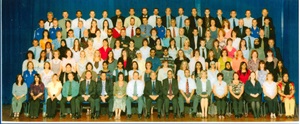
Pleckgate School Staff in 2008Back Row-Len Trueman, Terry Stephens, Michael Stokes, Val Murrey, Oliver Pellett, Andrew Birbeck, Greg Dean, Fabien Mercier, Dave Hunt,
Michael Johnson, Sean Ashmore, Chris Smithson, Phil Thompson, Paul Kenyon, Mark Holden, Mark Brownridge.
Sixth Row–Andrew Haworth, Ben Pickup, Suzanne Torrans, John Smith, Kath Huntress, Marie-Claire Langfield, Judith Mallam,
James McKenzie, Paul Harling, Andrew Wilkinson, Keith Ashworth, Craig Neilson, Mike Sumner, Jane Lippit, Zoe Millest, John Derbyshire, Stuart Cadman, James Clegg.
Fifth Row–Lee Rose, Sue Gordon, Dan Smith, Peter Smith, Ellie Wilson, Abdur- Rehman Patel, Mike Firth,
Sajid Mohmed, Fiona Hope, Lucy Laycock? Adam Goggon, Wendy Clarkson, Leslie Chapman, John Kay, Gordon Sudworth.
Forth Row–Dave Isherwood, Ruksana Quereshi, Safiyya Valli, Elizabeth Parker, Debbie Woods, Kristina Baird-Dean,
Margaret Evans, Nichola Stanton, Susan Coville, Jenny Wilden, Katy Punch, Dorothy Fletcher,
David Cowans, Sue Kenyon, Sarah Redfearn, Ozman Kazee, Austin Lynch.
Third Row–Joan Taylor, Janet Williams, Shirley Ward, Maggie Lynen, Cathy Fleming, Gemma Bracewell,
Sam Weldman, Sophie Karolia, Ismail Kharban, Javid Iqbal, Victoria Williams, Tracey Gilland,
Belinda Brain, Cheryl Williams, Michelle Varzanda, Josie Simms.
Second Row–Janine Blears, Susan Haworth, Janet Haworth, Pat Rushton, Ruksana Patel, Aneeza Khan
Flo Gilbert, Janet Archer, Janet Conlon, Chris Dobson, Anise Mohmed, Nuheeda Hussain, Salma Patel, Afsana Patel, Gail Wilson, Shahesta Raji.
First Row–Mel Denton, Samina Essak, Anne Taylor, Tony Cozzolino, Mark Bradshaw, Peter Briggs, Carol Sourbuts,
Andy Toone, Robin Campbell, Ian Morgan, Rob Hamilton, Carol Mason, Amanda Ansbro, Ruth Cardwell, Stella Harrison, Helen O’Connor?
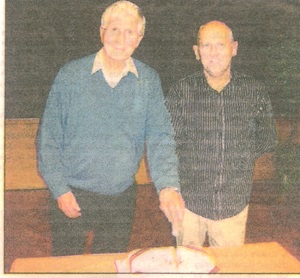
The School’s fortieth Anniversary held in the hall showing former Headteacher Keith Walmsley
and present Headmaster Robin Campbell cutting a celebration cake, July 2008
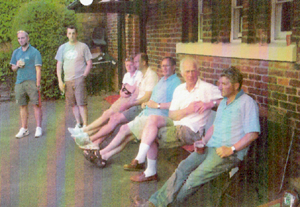
The Male Staff Bowls Night at Blackburn Subscriptions Bowling Club in 2009 with participants
Left–Right; Mr Loyns, Stuart Cadman, J. Herbert, Rob Hamilton, Ian Morgan, Rick Grogan Ian Eastwood
The 2010’s Era
The great advance in the school’s educational achievements culminated in it being chosen as the pioneer for the town’s “Building Schools for the Future” Programme. Balfour Beatty started building our new school to the rear of the existing one in January 2010 which was opened in September 2011. The old school was then demolished. The new school cost £25 million with modern facilities including flexible classroom learning zones with pupils receiving individual tablet PC’s and the school surrounded by attractive landscaped areas and once the old school was removed new sports and play areas.
In December 2010 Robin Campbell attended a reception at Clarence House in London to receive the Prince’s Teaching Institute Award for Geography from the Prince of Wales following a project by Miss Swales, Head of Geography. In April 2011, the Year Group 1977–1982 held a Reunion at the Spread- Eagle Hotel which was well attended.
There was also a successful school production of “Blood Brothers” held in 2011.
In June 2011, former staff and pupils were invited to its forthcoming relocation where they could also have a final look round the old school before it was demolished.
In July 2011 Ian Morgan, Anne Taylor, Carol Sourbuts and Sue Gordon. long serving staff retired. Robin Campbell retired in 2012 and Cherry Ridgeway was appointed the new Headteacher
In 2013 the school achieved its best ever GCSE results with a The school’s annual prize giving in November 2014 was made special when Padma Patel who starred in the Harry Potter movie “Goblet of Fire” attended to distribute the prizes and speak to the students.
By April 2015, the Deputy Head Nick Ford was named an Apple Distinguished Educator following his drive to integrate technology into the daily life at the school.
In November 2015 Mark Cocker was appointed as the new head of Pleckgate High School. He had been a Commonwealth Games wrestler and was now one of the youngest heads in the country.
pass rate of 71%. In the same year, as a reward for years seven and eight winning Blackburn School’s Cricket League they were taken to the England and South Africa T20 Cricket International in September played at Old Trafford.
Another initiative in 2013 was the appointment of new Senior Prefects chosen in Year ten for their final year eleven. In March 2013, a group of pupils were taken on a skiing holiday in the Italian Alps, whilst another group visited New York, USA.
There was bad news in February 2014 when the school was put in special measures by Ofsted due to a culture of mistrust within the school. This then led to the local authority placing four additional governors on the school’s governing body. The headteacher, Cherry Ridgeway was placed on paid leave and the deputy head Mark Bradshaw took over as acting school head. In March 2014 it was announced that Cherry Ridgeway would not be returning to the school. By April Ofsted said that the actions taken now meant the school morale amongst its teachers was now improving.
The school’s annual prize giving in November 2014 was made special when Padma Patel who starred in the Harry Potter movie “Goblet of Fire” attended to distribute the prizes and speak to the students.
By April 2015, the Deputy Head Nick Ford was named an Apple Distinguished Educator following his drive to integrate technology into the daily life at the school.
In November 2015 Mark Cocker was appointed as the new head of Pleckgate High School. He had been a Commonwealth Games wrestler and was now one of the youngest heads in the country.
By January 2016, the school had moved to Academy status leaving Blackburn with Darwen Council and coming under the control of the Education Partnership Trust. Following this in February 2016 the school celebrated its best ever GCSE results with 58% passing grades A-C.
During June 2016, the school was placed in a top league table and became a “Beacon of Success” for disadvantaged children. During October2016 the school was placed in the top ten schools in the UK for the second successive year.
January 2017 saw some staff at the school starting a three-day strike over performance-related pay and they demonstrated outside the school. The strike was resolved via the unions.
During the month of January 2018 there was an unusual Charity event at the school organised by East-Lancashire Hospice with a “Bubble Rush” with a cannon firing out bubbles and foam into the sky, thirty Year seven pupils enjoyed the bubbles. There was also a fun run organised for the month of May.
In February 2018, the Year seven and eight football teams were crowned champions of their respective leagues.
By March 2019, the school, which had been put in special measures five years previously, was ranked by Ofsted as “Outstanding” this was a remarkable achievement.
In April 2019, a team of budding “Rocketeers” made it through to the regional finals of a national engineering competition. In July the school won national recognition at the Education Business awards in London with an “Outstanding Progress award”.
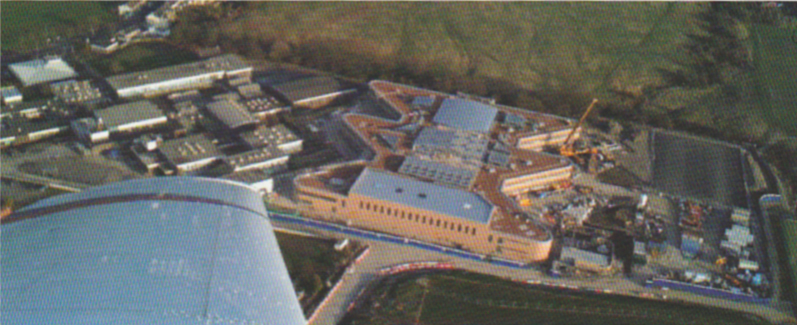
Aerial view of the new Pleckgate High School in 2011 and an internal view of its facilities being viewed by the Headteacher Robin Campbell
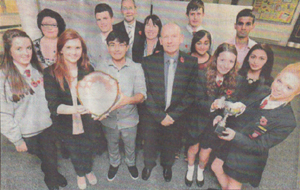
Staff and Pupils celebrating at the school’s annual awards evening in November 2011
Robin Campbell the school’s headteacher in his office in 2012. prior to his retirement
Demolition of the old school in 2012
All pupils were given an iPad In May 3013
Head of Technology, Helen O’Connor with year seven pupils hosting a Food Revolution Day for pupils. in May 2014
Acting Head Mark Bradshaw at the front of school celebrating with pupils after inspectors
rated the school having significantly improved after its previous troubles in December 2014
The school’s newly appointed head, Mark Cocker who started his duties in January 2016. Taken November 2015
June 2016 the school was named “School of the Year” in the East Lancashire Schools Awards.
The headmaster is seen celebrating with his pupils in front of the school
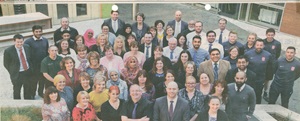
March 2017 staff are pictured celebrating as the school was recognised for helping students reach their full potential
The headmaster celebrating with pupils following inspectors rating the school “Outstanding” in March 2019
In September 2021, the school opened its doors and hosted its first post-covid Open evening to welcome new pupils to the school prior to their start in September 2022.
In February 2022, the school became one of only eight schools in the UK to become an Anne Frank Trust Link School which promotes a society safe from prejudice and discrimination.
In October 2023, the school’s Eco Club entered a Council run competition to use recycled products to create sculptures.
In May 2024 two teachers from the school Jade Banks and Charlotte Bland were short-listed for Education Today Awards with Jade forming and developing the school’s Eco Club and Charlotte developing Shakespeare in the school and leading the school production of “Oliver”.
In 2024 Aishling McGinty was appointed the new headteacher who moved up from deputy head.

Students celebrating their exam results at the school’s front entrance in August 2021
head teacher and senior staff with pupils celebrating as Ofsted rated the school “Outstanding” again in May 2024
More comprehensive information on events that took place at Pleckgate High School between 1968-2024 can be found in Mr. Sumner’s school archive held at Blackburn’s Main Library within the Community History Department.
Published August 2025

